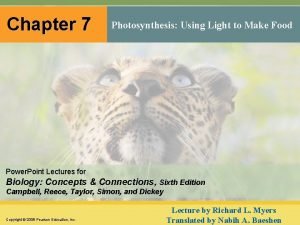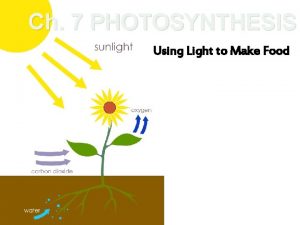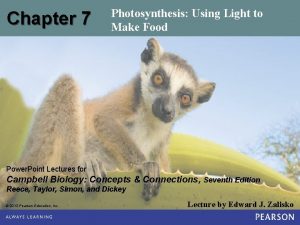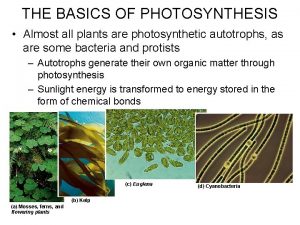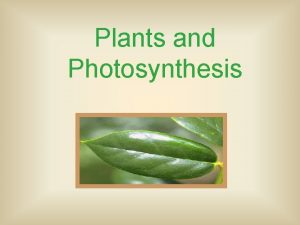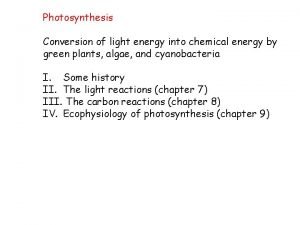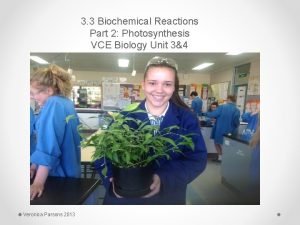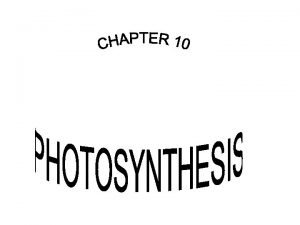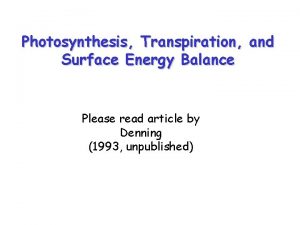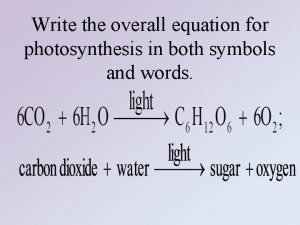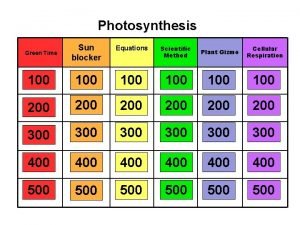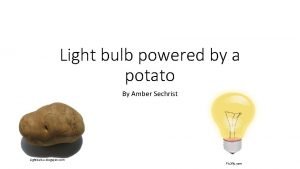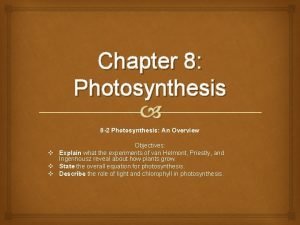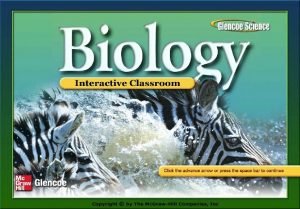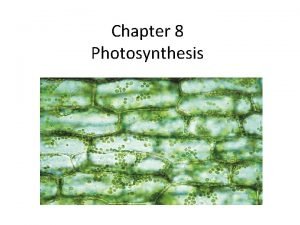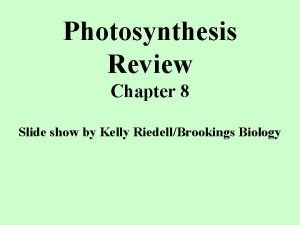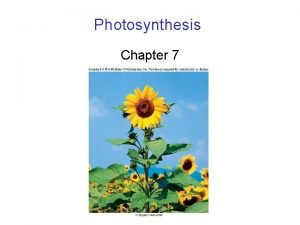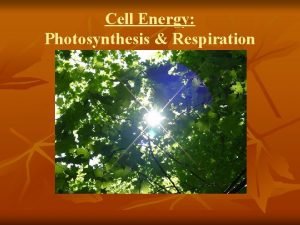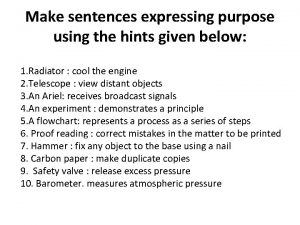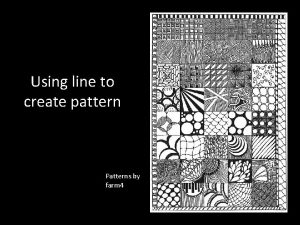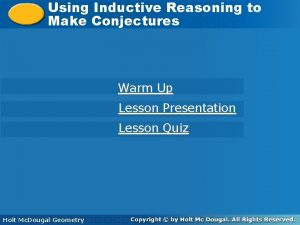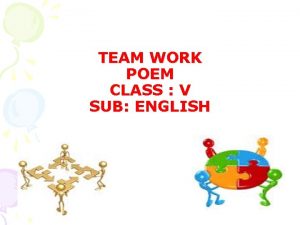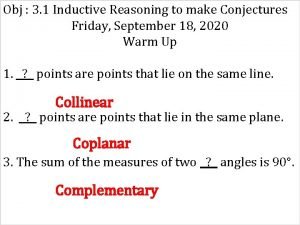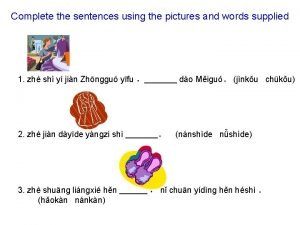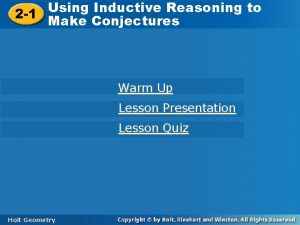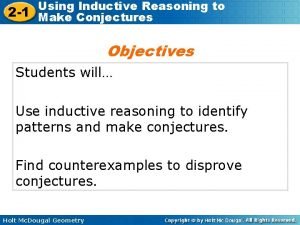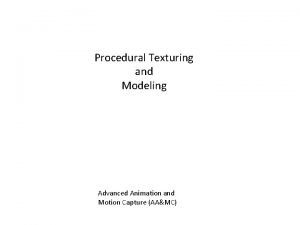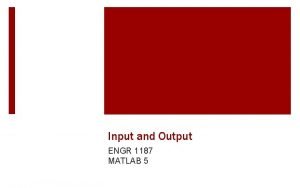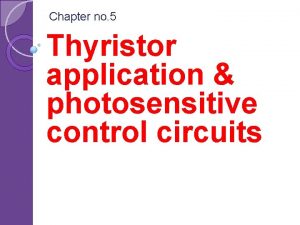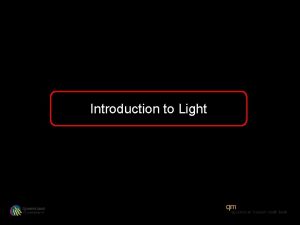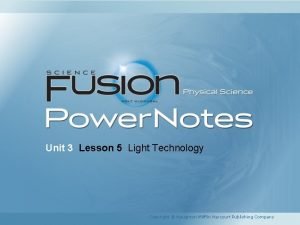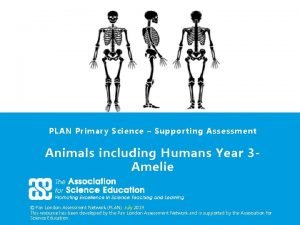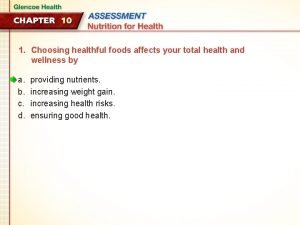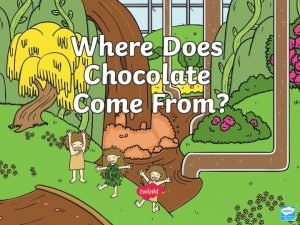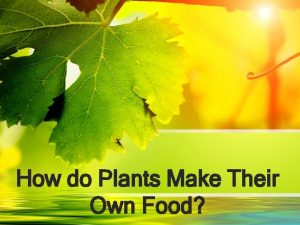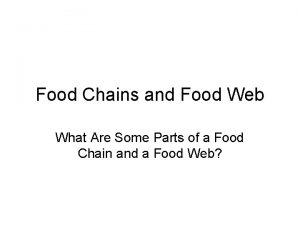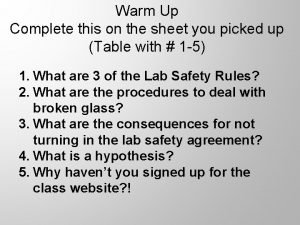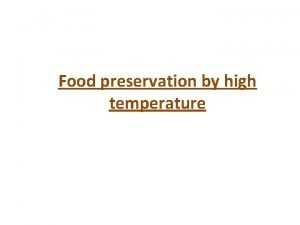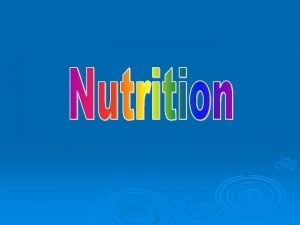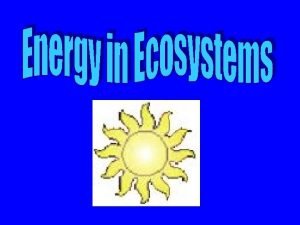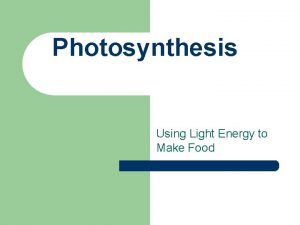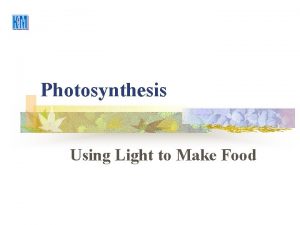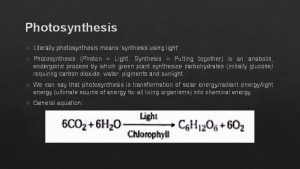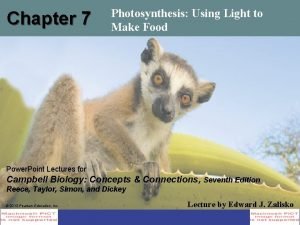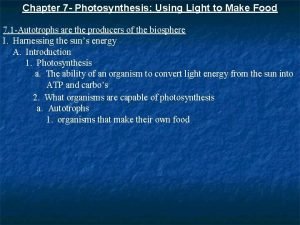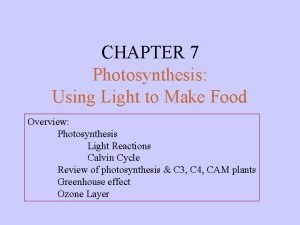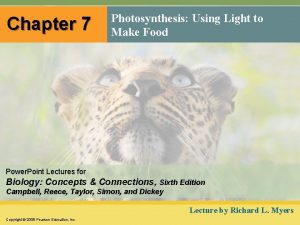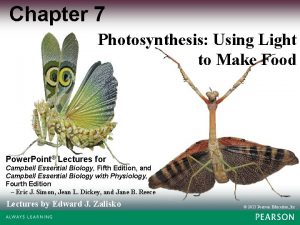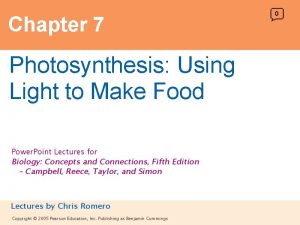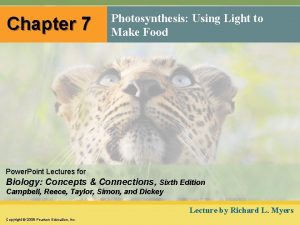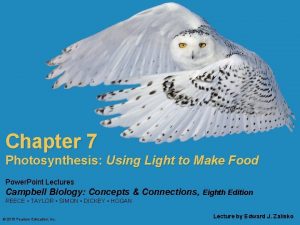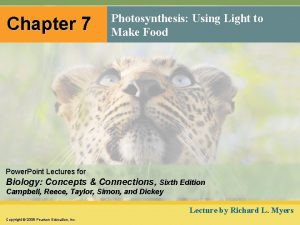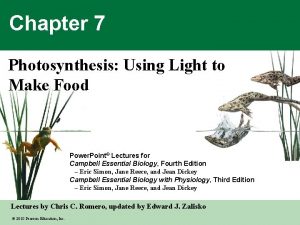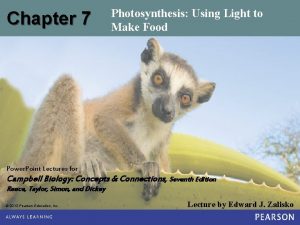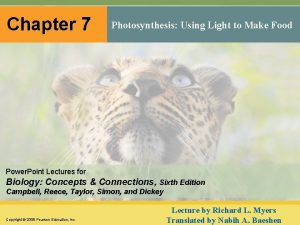Chapter 7 Photosynthesis Using Light to Make Food













































































- Slides: 77

Chapter 7 Photosynthesis: Using Light to Make Food Power. Point Lectures for Campbell Biology: Concepts & Connections, Seventh Edition Reece, Taylor, Simon, and Dickey © 2012 Pearson Education, Inc. Lecture by Edward J. Zalisko

Introduction § Plants, algae, and certain prokaryotes – convert light energy to chemical energy – by the process of photosynthesis and – store the chemical energy in sugar, made from – carbon dioxide and – water. © 2012 Pearson Education, Inc.

Figure 7. 0_2 Unicellular algae

Introduction § Algae farms can be used to produce – oils for biodiesel or – carbohydrates to generate ethanol. – Unlike biofuel crops such as corn, algae don’t require large areas of fertile land, and they grow fast. © 2012 Pearson Education, Inc.

Figure 7. 0_1 Chapter 7: Big Ideas An Overview of Photosynthesis The Calvin Cycle: Reducing CO 2 to Sugar The Light Reactions: Converting Solar Energy to Chemical Energy Photosynthesis Reviewed and Extended

AN OVERVIEW OF PHOTOSYNTHESIS © 2012 Pearson Education, Inc.

7. 1 Autotrophs are the producers of the biosphere § Autotrophs – make their own food through the process of photosynthesis, and do not usually consume organic molecules derived from other organisms. – There are two kinds of autotrophs – Photoautotrophs- use the energy of light to produce organic molecules. Eg: Plants, algae, some protists & cyanobacteria – Chemoautotrophs- are prokaryotes that use energy in inorganic chemicals as their energy source. Eg: Sulfur bacteria that live in deep-ocean vents © 2012 Pearson Education, Inc.

Figure 7. 1 A-D Photoautotroph diversity Plants Cyanobacteria Photosynthetic Kelp, a multicellular alga protists

7. 1 Autotrophs are the producers of the biosphere § Heterotrophs – are consumers that feed on other organisms (such as plants, animals, or decomposing organic material) – All animals – Humans – Fungi – Protists (that are not autotrophs) – Bacteria (except cyanobacteria) © 2012 Pearson Education, Inc.

7. 1 Autotrophs are the producers of the biosphere § Photosynthesis – converts carbon dioxide and water – into organic molecules, and releases oxygen. Light energy 6 CO 2 © 2012 Pearson Education, Inc. 6 H 2 O C 6 H 12 O 6 6 O 2

Figure 7. 2_1 Cross section of a Leaf Cross Section Leaf Mesophyll Vein Mesophyll Cell CO 2 Stoma Chloroplast

7. 2 Photosynthesis occurs in chloroplasts in plant cells § Mesophyll is the green tissue in the interior of the leaf. Chloroplasts are concentrated in mesophyll cells § Stomata are tiny pores in the leaf that allow – carbon dioxide to enter and – oxygen to exit. § Veins in the leaf deliver water absorbed by roots. © 2012 Pearson Education, Inc.

Figure 7. 2_2 Structure of Chloroplasts Chloroplast Inner and outer membranes Granum Thylakoid space Stroma

7. 2 Photosynthesis occurs in chloroplasts in plant cells § Chloroplasts – are the major sites of photosynthesis in green plants. – Chloroplasts consist of photosynthetic pigments, enzymes, and other molecules grouped together in membranes – There about half a million chloroplasts per square millimeter of leaf surface. © 2012 Pearson Education, Inc.

7. 2 Photosynthesis occurs in chloroplasts in plant cells § Chloroplasts – Consist of an envelope of two membranes, inner & outer membrane – Inner compartment is filled with a thick fluid called stroma – Contain a system of interconnected membranous sacs called thylakoids. – Stacks of thylakoides are called grana and © 2012 Pearson Education, Inc.

7. 2 Photosynthesis occurs in chloroplasts in plant cells § Chlorophyll – molecules are built into the thylakoid membrane and – is an important light-absorbing pigment in chloroplasts, – is responsible for the green color of plants, and – plays a pivotal role in converting solar energy to chemical energy. © 2012 Pearson Education, Inc.

Figure 7. 3 A Bubbles on the leaves of an aquatic plant Q: Which gas is in the bubbles?

7. 3 SCIENTIFIC DISCOVERY: Scientists traced the process of photosynthesis using isotopes § Scientists have known since the 1800 s that plants produce O 2. But does this oxygen come from carbon dioxide or water? – For many years, it was assumed that oxygen was extracted from CO 2 taken into the plant. – However, later research using a heavy isotope of oxygen, 18 O, confirmed that oxygen produced by photosynthesis comes from H 2 O. © 2012 Pearson Education, Inc.

Figure 7. UN 01 Photosynthesis Light energy 6 CO 2 Carbon dioxide 6 H 2 O Water C 6 H 12 O 6 Photosynthesis Glucose 6 O 2 Oxygen gas

7. 3 SCIENTIFIC DISCOVERY: Scientists traced the process of photosynthesis using isotopes Experiment 1: 6 CO 2 12 H 2 O → C 6 H 12 O 6 6 H 2 O 6 O 2 Experiment 2: 6 CO 2 12 H 2 O → C 6 H 12 O 6 6 H 2 O 6 O 2 © 2012 Pearson Education, Inc.

Figure 7. 3 B Reactants: Products: Q: Photosynthesis produces billions of tons of carbohydrates a year. Where does most of the mass of this huge amount of organic matter come from?

7. 4 Photosynthesis is a redox process, as is cellular respiration § Photosynthesis, – like respiration, is a redox (oxidation-reduction) process. – CO 2 becomes reduced to sugar as electrons along with hydrogen ions from water are added to it. – Water molecules are oxidized when they lose electrons along with hydrogen ions. © 2012 Pearson Education, Inc.

Figure 7. 4 A Photosynthesis is a redox (reduction & oxidation) process Becomes reduced Becomes oxidized

Figure 7. 4 A Photosynthesis (uses light energy) Becomes reduced Becomes oxidized Becomes reduced Cellular respiration (releases chemical energy)

7. 4 Photosynthesis is a redox process, as is cellular respiration § Cellular respiration – The electrons lose potential as they travel down the electron transport chain to O 2. – Harvests chemical energy from food molecules. § Photosynthesis – Light energy is captured by chlorophyll molecules to boost the energy of electrons, – The electrons gain energy as they travel climb uphill. – Light energy is converted to chemical energy, and – Chemical energy is stored in the chemical bonds of sugars. © 2012 Pearson Education, Inc.

7. 5 Overview: The two stages of photosynthesis are linked by ATP and NADPH § Photosynthesis occurs in two metabolic stages – Light reactions: Light energy is converted in the to chemical energy and O 2 in the thylakoid membranes – Calvin cycle: CO 2 is incorporated into organic compounds in the stroma – Calvin cycle is sometimes referred to as dark reactions because it does not need light directly Copyright © 2009 Pearson Education, Inc.

7. 5 Overview: The two stages of photosynthesis are linked by ATP and NADPH § Light reactions – Occur in the thylakoid membranes. – In these reactions, water is split, providing a source of electrons and giving off oxygen as a by-product, – ATP is generated from ADP and a phosphate group, and – Light energy is absorbed by the chlorophyll molecules to drive the transfer of electrons and H+ from water to the electron acceptor NADP+ reducing it to NADPH. – NADPH produced by the light reactions provides the electrons for reducing carbon in the Calvin cycle. © 2012 Pearson Education, Inc.

7. 5 Overview: The two stages of photosynthesis are linked by ATP and NADPH § Calvin cycle, – Occurs in the stroma of the chloroplasts – During the Calvin cycle, CO 2 is incorporated into organic compounds in a process called carbon fixation. – After carbon fixation, enzymes of the cycle make sugars by further reducing the carbon compounds. – The Calvin cycle is often called the dark reactions or lightindependent reactions, because none of the steps requires light directly. © 2012 Pearson Education, Inc.

Figure 7. 5_s 1 H 2 O Light NADP+ ADP P Light Reactions (in thylakoids) Chloroplast

Figure 7. 5_s 2 H 2 O Light NADP+ ADP P Light Reactions (in thylakoids) ATP NADPH Chloroplast O 2

Figure 7. 5_s 3 H 2 O CO 2 Light NADP+ ADP P Calvin Cycle (in stroma) Light Reactions (in thylakoids) ATP NADPH Chloroplast O 2 Sugar

THE LIGHT REACTIONS: CONVERTING SOLAR ENERGY TO CHEMICAL ENERGY © 2012 Pearson Education, Inc.

7. 6 Visible radiation absorbed by pigments drives the light reactions § Sunlight – Contains energy called electromagnetic energy or electromagnetic radiation. – Visible light is only a small part of the electromagnetic spectrum, the full range of electromagnetic wavelengths. – Electromagnetic energy travels in waves, and the wavelength is the distance between the crests of two adjacent waves. – The shorter the wavelength, the greater the energy. © 2012 Pearson Education, Inc.

Figure 7. 6 A Increasing energy 10 5 nm 10 3 nm Gamma rays X-rays 103 nm 1 nm UV 106 nm Infrared 103 m 1 m Microwaves Radio waves Visible light 380 400 500 600 Wavelength (nm) The electromagnetic spectrum 700 650 nm 750

7. 6 Visible radiation absorbed by pigments drives the light reactions § Light – Behaves as discrete packets of energy called photons. – A photon is a fixed quantity of light energy. – The shorter the wavelength, the greater the energy in photons. © 2012 Pearson Education, Inc.

7. 6 Visible radiation absorbed by pigments drives the light reactions § Pigments – absorb light and – are built into the thylakoid membrane. – Plant pigments absorb some wavelengths of light and – reflect or transmit other wavelengths. § We see the color of the wavelengths that are transmitted. For example, chlorophyll transmits green wavelengths. © 2012 Pearson Education, Inc.

Animation: Light and Pigments Right click on animation / Click play © 2012 Pearson Education, Inc.

Figure 7. 6 B Light Reflected light Chloroplast Thylakoid Absorbed light Transmitted light

7. 6 Visible radiation absorbed by pigments drives the light reactions § Different pigments, which absorb light of different wavelengths. – Chlorophyll a absorbs blue-violet and red light and reflects green. – Chlorophyll b absorbs blue and orange and reflects yellow-green. – Carotenoids – (accessory pigments) Their role is to capture sunlight and transfer to chlorophyll. – Eg: Carotene (Orange) ; Xanthophyll (Yellow) Yellow © 2012 Pearson Education, Inc.

7. 7 Photosystems capture solar energy § Pigments in chloroplasts absorb photons, which – increases the potential energy of the pigment’s electrons and – sends the electrons into an unstable state. – These unstable electrons drop back down to their “ground state, ” and – as they drop down, they release their energy as heat and light. © 2012 Pearson Education, Inc.

Figure 7. 7 A A solution of chlorophyll glowing red when illuminated Excited state Photon of light Heat Photon (fluorescence) Ground state Chlorophyll molecule

7. 7 Photosystems capture solar energy § Photosystems – In the thylakoid membrane, chlorophyll molecules are organized along with other pigments and proteins into photosystems. – A photosystem consists of a number of light-harvesting complexes surrounding a reaction-center complex. – A light-harvesting complex contains various pigment molecules bound to proteins. – Collectively, the light-harvesting complexes function as a light-gathering antenna. © 2012 Pearson Education, Inc.

Figure 7. 7 B Photosystem Light-harvesting Reaction-center complexes complex Thylakoid membrane Primary electron acceptor Transfer of energy Pair of chlorophyll a molecules Pigment molecules

7. 7 Photosystems capture solar energy § Photosystems – The light energy is passed from molecule to molecule within the photosystem. – Finally it reaches the reaction center where a primary electron acceptor accepts these electrons and consequently becomes reduced. – This solar-powered transfer of an electron from the reaction-center pigment to the primary electron acceptor is the first step in the transformation of light energy to chemical energy in the light reactions. – There are two types of photosystems, I and II. © 2012 Pearson Education, Inc.

7. 7 Photosystems capture solar energy § Photosystem I – This photosystem functions second, – It is called P 700 because it absorbs light of 700 nm. § Photosystem II – This photosystem functions first, – It is called P 680 because its absorbs light of 680 nm. § The two photosystems are connected by an electron transport chain © 2012 Pearson Education, Inc.

Figure 7. 8 A Electron Flow in the Light Reactions Light Photosystem II Stroma Electron transport chain Provides energy for synthesis of ATP by chemiosmosis NADP H Light Photosystem I 1 Primary acceptor Thylakoid membrane Primary acceptor 2 4 P 700 P 680 Thylakoid space 3 H 2 O 1 2 5 O 2 2 H 6 NADPH

7. 8 Two photosystems connected by an electron transport chain generate ATP and NADPH § Electron flow in the light reactions (from water to NADP) – Electrons removed from water – Gain energy passed from pigments and excited to a higher energy level – Photo excited high-energy electrons are captured by a primary electron acceptor – High energy electrons travel from photosystem II to photosystem I – Between the two photosystems, the electrons move down an electron transport chain. –. © 2012 Pearson Education, Inc.

Figure 7. 8 B A mechanical analogy of the light reactions ATP Photon Photosystem II Phot Mill makes ATP on NADPH Photosystem I

7. 9 Chemiosmosis powers ATP synthesis in the light reactions § Generation of ATP in the light reactions – The energy released by the electrons “falling” in the electron transport chain is used to pump H+ into the thylakoid space, and – This results in a concentration gradient of H+ across the thylakoid membrane – The energy in the concentration gradient drives H+ back to the stroma through ATP synthase, producing ATP. © 2012 Pearson Education, Inc.

Figure 7. 9 The production of ATP by Chemiosmosis Chloroplast To Calvin Cycle Light Stroma (low H+ concentration) ADP H+ NADP+ H+ P NADPH H+ H+ H+ Thylakoid membrane H 2 O Thylakoid space (high H+ concentration) 1 O + 2 + H 2 2 Photosystem II H+ H + H+ Electron transport chain H+ H+ Photosystem I H+ H+ H+ ATP synthase ATP

7. 9 Chemiosmosis powers ATP synthesis in the light reactions § Photophosphorylation, – Production of ATP using the initial energy input from light © 2012 Pearson Education, Inc.

7. 9 Chemiosmosis powers ATP synthesis in the light reactions § How does photophosphorylation compare with oxidative phosphorylation? – Mitochondria use oxidative phosphorylation to transfer chemical energy from food into the chemical energy of ATP. – Chloroplasts use photophosphorylation to transfer light energy into the chemical energy of ATP. © 2012 Pearson Education, Inc.

7. 8 Two photosystems connected by an electron transport chain generate ATP and NADPH § The products of the light reactions are – NADPH, – ATP, and – Oxygen. © 2012 Pearson Education, Inc.

THE CALVIN CYCLE: REDUCING CO 2 TO SUGAR © 2012 Pearson Education, Inc.

7. 10 ATP and NADPH power sugar synthesis in the Calvin cycle § Calvin cycle – Makes sugar within a chloroplast. – Using atmospheric CO 2 and – ATP and NADPH generated by the light reactions. – Produces an energy-rich, three-carbon sugar called glyceraldehyde-3 -phosphate (G 3 P). – A plant cell may then use G 3 P to make glucose and other organic molecules. © 2012 Pearson Education, Inc.

Figure 7. 10 A An overview of the Calvin cycle Input CO 2 ATP NADPH Calvin Cycle Output: G 3 P

7. 10 ATP and NADPH power sugar synthesis in the Calvin cycle § The steps of the Calvin cycle include 1. carbon fixation, 2. reduction, 3. release of G 3 P, and 4. regeneration of the starting molecule ribulose bisphosphate (Ru. BP). © 2012 Pearson Education, Inc.

Figure 7. 10 B_s 1 Step 1 Carbon fixation Input: 3 CO 2 Rubisco 1 3 P 6 P Ru. BP 3 -PGA Calvin Cycle P

Figure 7. 10 B_s 2 Step 1 Carbon fixation Input: 3 CO 2 Rubisco 1 3 P Step 2 Reduction 6 P Ru. BP 3 -PGA P 6 ATP 6 ADP Calvin Cycle 2 6 NADPH 6 P G 3 P 6 NADP P

Figure 7. 10 B_s 3 Step 1 Carbon fixation Input: 3 CO 2 Rubisco 1 3 P Step 2 6 P Ru. BP Reduction 3 -PGA P 6 ATP 6 ADP Calvin Cycle Step 3 Release of one molecule of G 3 P 5 G 3 P 2 6 NADPH 6 P P 6 NADP G 3 P 3 Output: 1 P G 3 P Glucose and other compounds P

Figure 7. 10 B_s 4 Step 1 Carbon fixation Input: 3 CO 2 Rubisco 1 3 P Step 2 6 P Ru. BP Reduction 3 -PGA P 3 ADP Calvin Cycle 4 5 G 3 P Step 4 Regeneration of Ru. BP ATP 6 ADP 3 ATP Step 3 Release of one molecule of G 3 P 6 2 6 NADPH 6 P P 6 NADP G 3 P 3 Output: 1 P G 3 P Glucose and other compounds P

7. 11 EVOLUTION CONNECTION: Other methods of carbon fixation have evolved in hot, dry climates § Most plants use CO 2 directly from the air, and carbon fixation occurs when the enzyme Rubisco adds CO 2 to Ru. BP. § Such plants are called C 3 plants because the first product of carbon fixation is a three-carbon compound, 3 -PGA. § Skip C 4 and CAM plants © 2012 Pearson Education, Inc.

PHOTOSYNTHESIS REVIEWED AND EXTENDED © 2012 Pearson Education, Inc.

7. 12 Review: Photosynthesis uses light energy, carbon dioxide, and water to make organic molecules § Most of the living world depends on the foodmaking machinery of photosynthesis. § The chloroplast – integrates the two stages of photosynthesis and – makes sugar from CO 2. © 2012 Pearson Education, Inc.

7. 12 Review: Photosynthesis uses light energy, carbon dioxide, and water to make organic molecules § About half of the carbohydrates made by photosynthesis are consumed as fuel for cellular respiration in the mitochondria of plant cells. § Sugars also serve as the starting material for making other organic molecules, such as proteins, lipids, and cellulose. § Excess food made by plants is stockpiled as starch in roots, tubers, seeds, and fruits. © 2012 Pearson Education, Inc.

Figure 7. 12 H 2 O Light CO 2 Chloroplast NADP Light Reactions ADP P Ru. BP Calvin Cycle 3 -PGA (in stroma) Photosystem II Electron transport chain Thylakoids Photosystem I ATP NADPH O 2 Stroma G 3 P Sugars Cellular respiration Cellulose Starch Other organic compounds

7. 13 CONNECTION: Photosynthesis may moderate global climate change § The greenhouse effect operates on a global scale. – Solar radiation includes visible light that penetrates the Earth’s atmosphere and warms the planet’s surface. – Heat radiating from the warmed planet is absorbed by gases in the atmosphere, which then reflects some of the heat back to Earth. – Without the warming of the greenhouse effect, the Earth would be much colder and most life as we know it could not exist. © 2012 Pearson Education, Inc.

Figure 7. 13 A

Figure 7. 13 B CO 2 in the atmosphere and the greenhouse effect Some heat energy escapes into space Sunlight Atmosphere Radiant heat trapped by CO 2 and other gases

7. 13 CONNECTION: Photosynthesis may moderate global climate change § The gases in the atmosphere that absorb heat radiation are called greenhouse gases. These include – water vapor, – carbon dioxide, and – methane. © 2012 Pearson Education, Inc.

7. 13 CONNECTION: Photosynthesis may moderate global climate change § Increasing concentrations of greenhouse gases have been linked to global climate change (also called global warming), a slow but steady rise in Earth’s surface temperature. § Since 1850, the atmospheric concentration of CO 2 has increased by about 40%, mostly due to the combustion of fossil fuels including – coal, – oil, and – gasoline. © 2012 Pearson Education, Inc.

7. 13 CONNECTION: Photosynthesis may moderate global climate change § The predicted consequences of continued warming include – melting of polar ice, – rising sea levels, – extreme weather patterns, – droughts, – increased extinction rates, and – the spread of tropical diseases. © 2012 Pearson Education, Inc.

7. 13 CONNECTION: Photosynthesis may moderate global climate change § Widespread deforestation has aggravated the global warming problem by reducing an effective CO 2 sink. § Global warming caused by increasing CO 2 levels may be reduced by – limiting deforestation, – reducing fossil fuel consumption, and – growing biofuel crops that remove CO 2 from the atmosphere. © 2012 Pearson Education, Inc.

7. 14 SCIENTIFIC DISCOVERY: Scientific study of Earth’s ozone layer has global significance § Solar radiation converts O 2 high in the atmosphere to ozone (O 3), which shields organisms from damaging UV radiation. § Industrial chemicals called CFCs (Chloro-flurocarbons) have caused dangerous thinning of the ozone layer, but international restrictions on CFC use are allowing a slow recovery. © 2012 Pearson Education, Inc.

Figure 7. 14 A The ozone hole in the Southern Hemisphere, spring 2006 Southern tip of South America Antarctica

Learning from plants

Figure 7. UN 02 NADP P NADPH
 Chapter 7 photosynthesis using light to make food
Chapter 7 photosynthesis using light to make food Photosynthesis using light to make food
Photosynthesis using light to make food Using light to make food
Using light to make food Light light light chapter 23
Light light light chapter 23 Into the light chapter 22
Into the light chapter 22 Chapter 22
Chapter 22 What is the word equation of photosynthesis
What is the word equation of photosynthesis Green plants make their own food by photosynthesis
Green plants make their own food by photosynthesis Inputs of light reactions in photosynthesis
Inputs of light reactions in photosynthesis Granum
Granum Chemical form of energy
Chemical form of energy How to measure photosynthesis
How to measure photosynthesis Reaction of photosynthesis
Reaction of photosynthesis Light and dark reactions of photosynthesis
Light and dark reactions of photosynthesis Photosynthesis transforms light energy into chemical energy
Photosynthesis transforms light energy into chemical energy Unit 2 food food food
Unit 2 food food food Food chain food chain food chain
Food chain food chain food chain Write the overall equation for photosynthesis using words
Write the overall equation for photosynthesis using words The food that plants produce during photosynthesis is
The food that plants produce during photosynthesis is Photosynthesis food web
Photosynthesis food web Make the lie big, make it simple
Make the lie big, make it simple Steve angrisano go make a difference
Steve angrisano go make a difference Make the lie big, make it simple
Make the lie big, make it simple To mix ingredients gently in a circular motion
To mix ingredients gently in a circular motion Potato light bulb
Potato light bulb Put out that light
Put out that light Membrane-bound organelles
Membrane-bound organelles The bouncing off of light.
The bouncing off of light. What are the materials that block light
What are the materials that block light Chapter 8 section 2 photosynthesis answer key
Chapter 8 section 2 photosynthesis answer key Chapter 8 section 2: photosynthesis
Chapter 8 section 2: photosynthesis Chapter 9 lesson 2 photosynthesis an overview
Chapter 9 lesson 2 photosynthesis an overview Atp and adp cycle
Atp and adp cycle Products of photosynthesis
Products of photosynthesis Mcgraw hill photosynthesis
Mcgraw hill photosynthesis How do plants get glucose
How do plants get glucose Make sentences using the past simple and past continuous
Make sentences using the past simple and past continuous Make sentences expressing purpose
Make sentences expressing purpose Making predictions with experimental probability
Making predictions with experimental probability Simple line patterns
Simple line patterns Using inductive reasoning to make conjectures
Using inductive reasoning to make conjectures Make an acrostic poem using the word teamwork.
Make an acrostic poem using the word teamwork. Using inductive reasoning to make conjectures
Using inductive reasoning to make conjectures How do you make predictions using theoretical probability
How do you make predictions using theoretical probability Label the pictures and complete the sentences
Label the pictures and complete the sentences What is deductive reasoning
What is deductive reasoning Using inductive reasoning to make conjectures
Using inductive reasoning to make conjectures Acrostic poem meaning
Acrostic poem meaning Make a dialogue about greeting and leave taking
Make a dialogue about greeting and leave taking How to make a roulette wheel in c using srand
How to make a roulette wheel in c using srand Example of acrostic poem using the word catalyst
Example of acrostic poem using the word catalyst How to make a table in matlab using fprintf
How to make a table in matlab using fprintf How to make money using machine learning
How to make money using machine learning Thyristor application
Thyristor application Introduction of light
Introduction of light Lesson 5 using light
Lesson 5 using light System collections generic
System collections generic Defrost using internal heat is accomplished using
Defrost using internal heat is accomplished using Animals can make their own food
Animals can make their own food Animals can make their own food
Animals can make their own food Pests can cause which two types of contamination?
Pests can cause which two types of contamination? Total health foods
Total health foods What food do plants make
What food do plants make Make delicious food
Make delicious food A cook uses a cleaning towel to wipe up spills
A cook uses a cleaning towel to wipe up spills How indoor plants make their food
How indoor plants make their food Parts of the food chain
Parts of the food chain Organisms that make their own food
Organisms that make their own food Food preservation
Food preservation Food scientists measure food energy in:
Food scientists measure food energy in: Which food is a tcs food
Which food is a tcs food Tcs food
Tcs food Very little very few
Very little very few Primary secondary tertiary food chain
Primary secondary tertiary food chain Food handlers can contaminate food when they:
Food handlers can contaminate food when they: Fast food nation summary
Fast food nation summary The many overlapping food chains in an ecosystem
The many overlapping food chains in an ecosystem Producer in the food web
Producer in the food web
